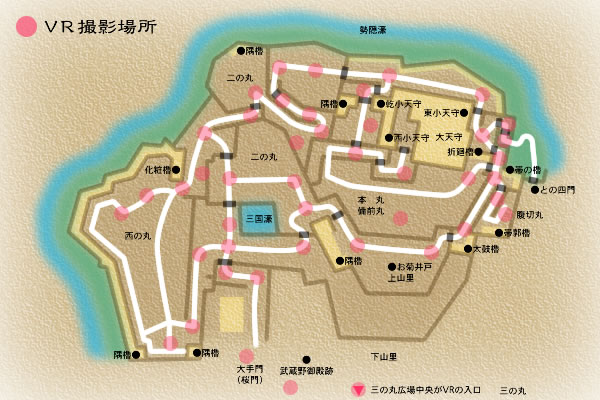姫路城:Himeji-Jo
所在地:兵庫県姫路市本町 Location: Motomachi, Himeji City, Hyogo.

姫路城の概要
城区分:平山城
国宝:大天守、西小天守、乾小天守、東小天守、イ・ロ・ハ・ニの渡櫓
重要文化財:門・土塀・櫓など国宝を除く74棟
Outline of Himeji Castle
The kind: Hira-Yama-shiro.
Japanese National treasure: large Tensyu, west-smallness Tensyu, Inui-smallness Tensyu, an east-smallness Tensyu, and I, RO, HA, NI-no-watasi Yagura
Important cultural property: 74 except national treasures, such as a gate, Tuchi-Bori, and Yagura.
姫路城の歴史
姫路城の始まりははっきりしたことは分かっていませんが、鎌倉末期の1333(元弘3)年、播磨の守護職赤松則村が姫山に砦を築き、1346(正平元)年、息子貞範が城を構え、その後小寺、黒田氏が譲り受けたものとされていました。しかし最近の研究によれば黒田重隆・職隆父子が、16世紀中頃に築城したというものが、有力視されています。1577(天正5)年、重隆の孫、黒田官兵衛孝高が城主の時、中国地方からの毛利氏の驚異を食止めるべく、織田方の武将として羽柴秀吉が播磨に派遣されます。そして1581(天正9)年、三層の天守を持つ城を築城します。
秀吉の後、木下家定と城主は移りますが、1600(慶長5)年、関ヶ原の合戦で優れた功績を果たした徳川家康の娘婿池田輝政は、播磨の国を与えられます。そしてその翌年から8年の歳月を費やして五層七階の天守を完成させます。これが現在私たちが目にする姫路城天守です。内濠までは現存していますが、外濠は現在のJR山陽本線姫路駅までと広大な城域を持っていました。輝政が亡くなると、長男の利隆が城主になりますが、その後、早くに亡くなってしまいます。父の後を継いだ光政は、たったの7歳と幼かったため、江戸幕府によって鳥取に移され、かわりに伊勢国から本多忠政が城主として入封します。忠政の息子忠刻と室千姫夫婦のために西の丸を整備し、1618(元和4)年、姫路城の全容が整いました。明治維新を迎えるまでに城主は、松平、榊原、酒井氏と続きました。明治新政府は1873(明治6)年、全国各地に廃城令を出しましたが、姫路城は存城とされました。政府の考えるところの存城とは、保存目的ではなく陸軍省をその敷地内に置き、兵舎や訓練場として利用するためだったのです。この時まで残っていた多くの建物が次々と取り壊され、天守も荒れ果て崩れそうになるほど傾いていました。陸軍省中村重遠大佐は、天下の名城がくずれ落ちてしまう前に、何としてでも保存すべきだ。と考え意見書を政府の提出し1879(明治12)年、姫路城の保存が決定しました。菱の門の近くに中村大佐を讚える石碑が建てられています。
1908(明治41)年、姫路市民で白鷺城保存期成同盟会がつくられ、ねばり強い市民運動をくり広げ、1910(明治43)年、本格的な保存工事が行われることとなりました。1928(昭和3)年、史跡名勝天然記念物保存法で史跡に指定され、さらに翌年には国宝保存法が制定され、1931(昭和6)年、大天守をはじめ82棟の建物が国宝に指定されました。 1934(昭和9)年から修理が始まり、戦時中は中断していましたが、1950(昭和25)年、第一次六ケ年計画が開始。いずれ倒れる天守を守るための大修理、第二次八ケ年計画が1956(昭和31)年から開始します。昭和の築城と呼ばれるほどの大修理で天守は全て解体され、地盤にコンクリートを据え心柱を取り換えと、とてつもない大工事だったようです。その工事も1964(昭和39)年に完成します。1992(平成4)年、世界遺産条約に批准した我が国は、世界文化遺産として姫路城と法隆寺地域の仏教建造物を推薦し、翌年、ユネスコ世界遺産委員会は姫路城、法隆寺を、日本で初めての世界文化遺産に指定しました。
History of Himeji Castle
The exact origins of Himeji Castle are unknown. One theory is that the castle was built as a local defensive bastion by Akamastu Norimura [1277-1350] of Harima. His second son, Sadanori, expanded the original bastion and established it as a castle in 1346. However, according to recent research, Kuroda Shigetaka and his son, Mototaka, built the castle about the middle of the 16th century. Later in 1577 when the grandson of Shigetaka and Kuroda Kanbei Yoshitaka were daimyos of the castle, the Mori clan made a foray from the Chugoku district. In order to block this planned attack Hashiba Hideyoshi was despatched from Harima as Bu-syo of Oda. In 1580 Hideyoshi became Lord of Himeji and the Tensyu [with three floors] was built in 1581.
Now a daimyo castle, it is next transferred in 1600 from Hideyoshi's successor to Kinoshita Iesada, the son-in-law of Tokugawa Ieyasu, married to his daughter, Ikeda Mistumasa, for exhibiting great bravery at the bloody battle of Sekigahara. During the following eight years the five-storey Tensyu was completed. This is the Tensyu which we see now at Himeji. Although the castle complex extended up to the inner canal, the original outer canal extended to the site of the present Himeji station of the JR San'yo Line. Himeji was indeed a vast castle complex. Once Mistumasa passed away, his eldest son, Toshitaka, became the castle daimyo. However, it was transferred almost immediately since Toshitaka was only 7 years old. Governance of Himeji was given to Tottori by the Edo Bakufu, and Honda Tadamasa, from Ise-no-kuni, served as the castle daimyo. During the rule of Honda Tadamasa many of the castle's most beautiful buildings were erected. The Nishi-no-Maru was converted into a beautiful residence for his son Tadatoki and his wife Sen-Hime, [the daughter of the Shogun, Tokugawa Hideta,] and the final structure of Himeji Castle was completed in 1618.
Up until the time of the Meiji Restoration, the castle lordship continued with the Mastudaira family, the.Sakakibara family, and finally the Sakai family. In 1873 the new Meiji government considered destroying many castles around the country but decided not to demolish Himeji Castle. The rational for exempting Himeji Castle was to use it as a location for the Department of the Army, and using it as barracks or as a training site. It was allowed to remain standing for these reasons not for preservation purposes. Many buildings which remained until then were pulled down or demolished one after another, and the Tensyu began to lean and was likely to collapse into ruins. A Colonel of the Department of the Army, Nakamura Shigetou, desired to save one of the world's most noted castles before it collapsed. This was considered by the government and the preservation of Himeji Castle was decided upon in 1879. A monument in gratitude for the efforts of Colonel Nakamura was erected near the Hishi-no-Mon. A Hakuro-Jo preservation association was established by Himeji residents in 1908. Their tenacity, backed by a strong civic movement, meant that a full scale reconstruction project was begun in 1910. Two years later parts of the castle site were opened to the public. It was specified as a historic relic in 1928.
Furthermore, the procedure for identifying and saving national treasures was enacted the next year. The whole castle was placed under the control of the Ministry of Culture in 1931and 82 buildings were specified as national treasures. Although repairs began in 1934 and were interrupted during wartime, the first restoration plan [six years] began in 1950. The large repair program for protecting the Tensyu which was in danger of falling, and the second restoration plan [eight years] began in 1956. All Tensyus were disassembled and rebuilt on concrete foundations. The reconstruction was completed in 1964. Japan ratified the World Heritage Convention in 1992. Himeji Castle and the Horyuji Temple area were recommended as world cultural heritage sites , and the UNESCO world heritage committee specified Himeji Castle and Horyuji Temple to be the first world cultural heritages in Japan the following year.
